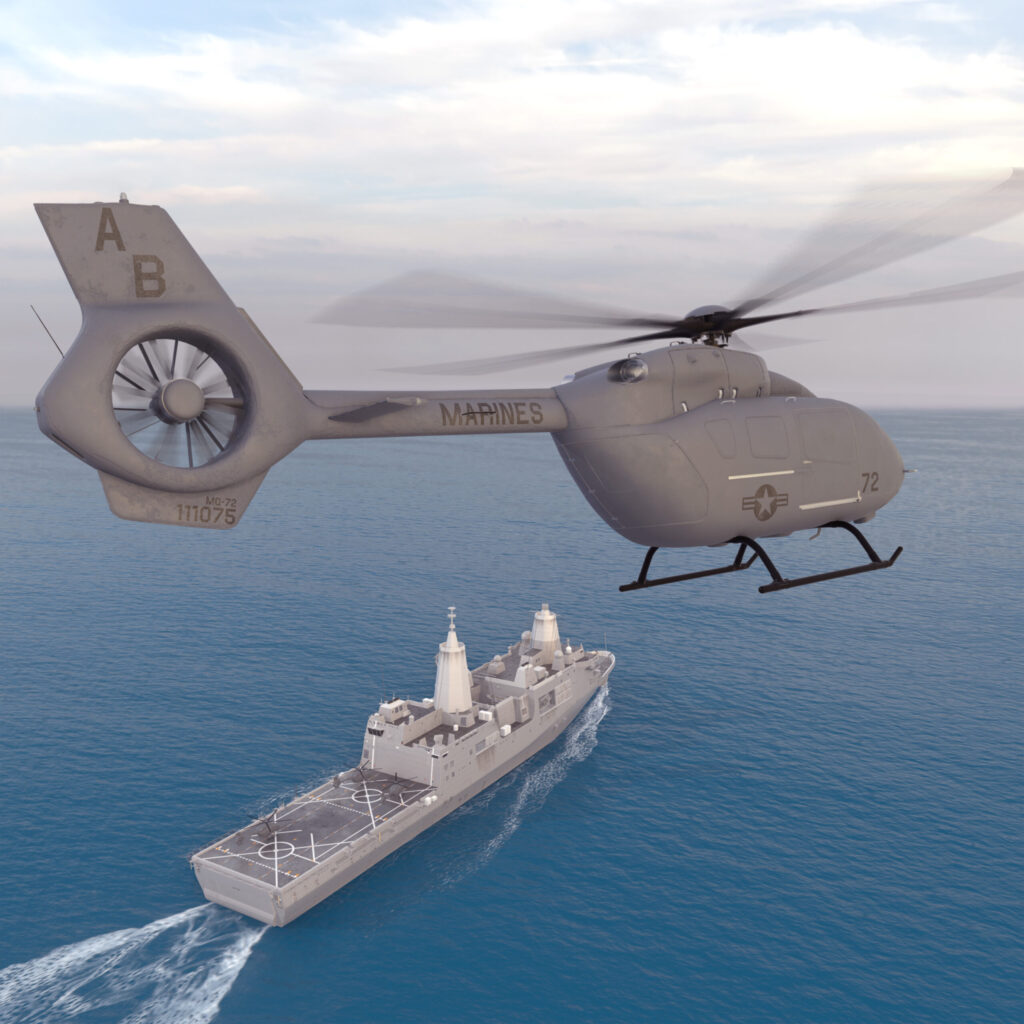
Rendering of Airbus’ MQ-72C, its offering for the Marine Corps’ Aerial Logistics Connector program. (Photo: Airbus)
Airbus U.S. has partnered with Shield AI to integrate its autonomy software on the unmanned version of the UH-72 Lakota aircraft it’s developing for the Marine Corps’ Aerial Logistics Connector (ALC) program, the companies said April 30.
Carl Forsling, Airbus U.S.’ director of business development and strategy, cited Shield AI’s “record of succeeding quickly” in integrating autonomous capabilities as a key factor in the decision to work together on developing the uncrewed MQ-72c cargo-carrying platform.
“That’s important as we have a very time-constrained program. We want to get this capability to the Marine Corps as fast as we can,” Forsling told sister publication Defense Daily during an interview at the Modern Day Marine conference in Washington, D.C. “As we progressed through initial design activities with NAVAIR, we flushed out the concept more. It became clear that we wanted to build a best of breed team here and go beyond the skill set that it’s in Airbus Group and go find partners like Shield AI that are leaders in their field.”
The Marine Corps last April selected Airbus for the competitive ALC development effort, with an aim to have a prototype that’s ready to transition into fielding within five years.
Airbus has said MQ-72C, the unmanned version of its UH-72 helicopter being developed for ALC, is intended to have a cruise speed of 135 knots, a maximum takeoff weight of over 8.300 pounds and a range above 350 nautical miles.
Under the newly-announced agreement, Shield AI will integrate its Hivemind autonomy software with Airbus’ Helionix avionics suite as it continues work developing the unmanned logistics platform.
“The Lakota has been a mainstay of military aviation for years—a widely-fielded, trusted platform used across a range of missions. Integrating Hivemind onto this aircraft shows how autonomy can rapidly enhance proven systems to meet the demands of today’s missions, and it’s a key step toward fully autonomous, uncrewed logistics operations that are scalable, resilient, and built for the future fight,” Ryan Tseng, CEO of Shield AI, said in a statement.
Forsling said there will be opportunities in the development process for ALC, while still working with a manned Lakota aircraft, to start to “exercise the autonomy tools to give a capability and demonstrate that we are reducing risk, reducing the schedule and budget required to actually bend the metal and make this a fielded prototype.”
“We’ve also done a couple of demo activities, starting with basically validating the initial capabilities of the aircraft from a performance perspective, payload, range, speed etc., of the Lakota and the maintainability and the sustainability and the ability to operate that in the field for long periods of time. So we validated a lot of those capabilities,” Forsling told Defense Daily.
The Marine Corps also selected a team led by Near Earth Autonomy, that also includes Honeywell and Leonardo Helicopters, for the ALC development effort.
The Near Earth-led ALC team is dividing the work into having Leonardo implement a fast-loading, security and unloading system for Joint Modular Intermodal Containers on its AW139 helicopter, Honeywell providing the helicopter’s autopilot that it will augment for autonomous take-off and landing and Near Earth demonstrating a full integrated logistics system with onboard autonomy to guide the aircraft and modify flight trajectory to avoid hazards.
A version of this story originally appeared in affiliate publication Defense Daily.